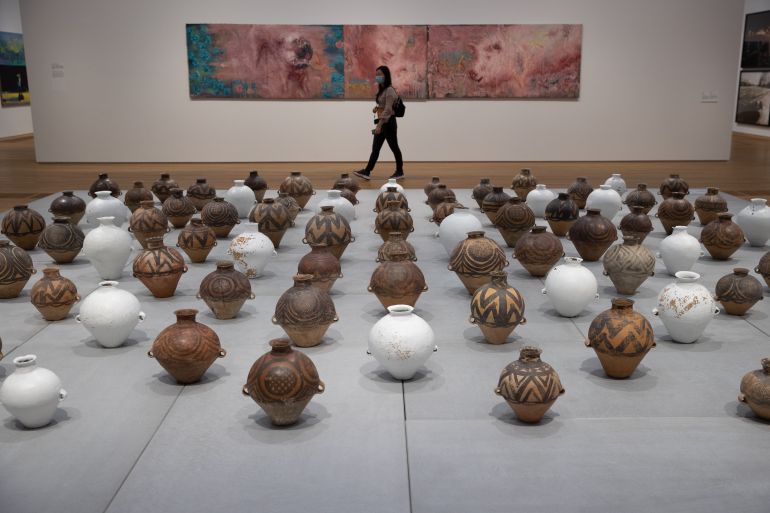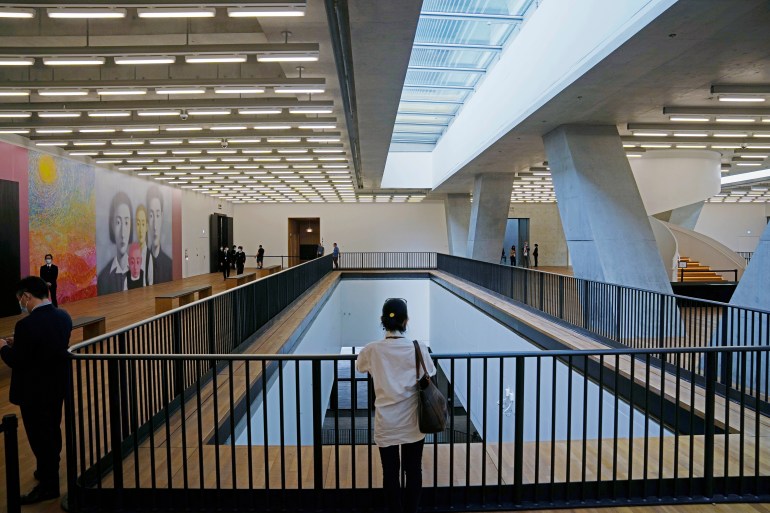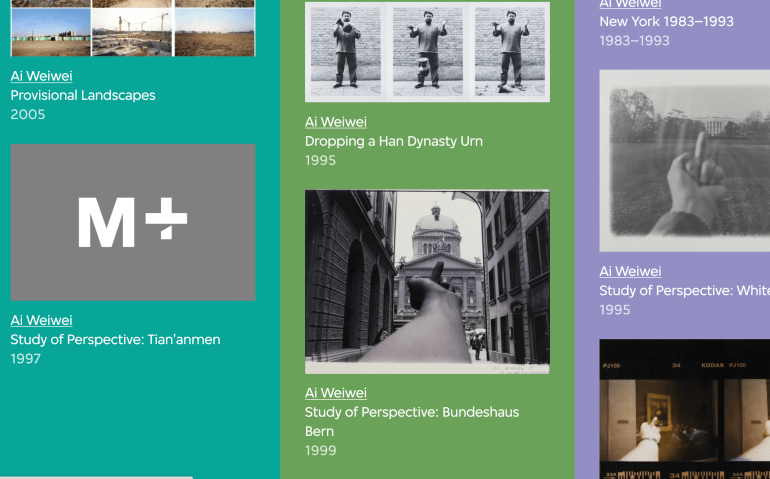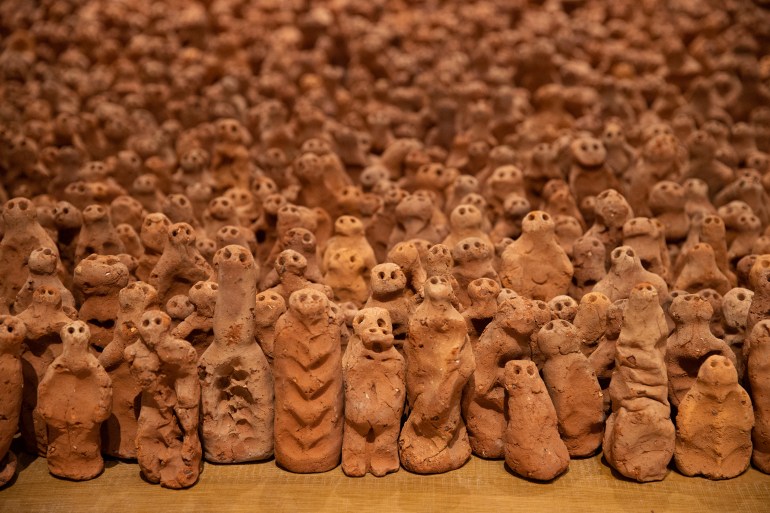Hong Kong opens top art museum amid fear of cultural ‘dark ages’
The long-delayed launch of M+ comes as Hong Kong artists and performers struggle with the impact of the National Security Law.

Hong Kong, China – Its cavernous reception hall affords a glimpse of the glittering view of Victoria Harbour. Its collection promises visitors a chance to see some of the world’s most significant works of art.
M+, designed by Herzog & de Meuron, the architects behind the Tate Modern in London, is being billed as Asia’s first global visual art museum.
Keep reading
list of 4 itemsOpposing Autocracy
Amnesty to close two Hong Kong offices, cites security law
Hong Kong activists jailed for unauthorised protest in 2020
The museum, which has been 14 years in the making and is the crown jewel of Hong Kong’s West Kowloon cultural district, opens on Friday at a politically-fraught time.
Even as the Chinese territory bids for a place on the world’s culture map and shed a past dominated by mercantile interests, a dark cloud of censorship in the name of safeguarding national security looms on the horizon.
“It’s a major development, a long time in the making. M+ has local, regional and global significance,” said Paul Gladston, a specialist on contemporary Chinese art at the University of New South Wales in Sydney. That said, it’ll have to “come to terms with finding ways to negotiate these problems in ways that are familiar in the mainland. It’s a fact now.”
In March, when M+ executive director Suhanya Raffel maintained during a media tour that it would not shy away from controversial works, Henry Tang, the district chief of West Kowloon wasted no time in clarifying that all exhibits would be subject to the purview of the National Security Law, which was imposed by China in June last year.

The legislation criminalises activities Beijing deems to be subversion, terrorism, collusion with foreign forces and secession with punishments of up to life in prison, and critics say it has ‘decimated‘ Hong Kong’s democratic freedoms.
The law “limits what M+ can do, and gives the perception that it limits what M+ can do,” Gladston told Al Jazeera. “That’s problematic.”
During a private tour of the museum last week, Doryun Chong, Chief Curator of M+, was asked about how his job had changed compared with when he was first appointed in 2013.
“The ground has shifted,” he said, “Things have changed a lot. There’s a lot of expectation and scrutiny.”
The same year, the largest ever exhibition of late American artist Andy Warhol was on tour in Asia, and while his Mao silkscreens were banned from Beijing and Shanghai, they were exhibited in Hong Kong.
This year, just a few months before its grand opening, the museum released a statement saying a photograph by exiled Chinese artist Ai Weiwei showing Ai flipping the bird in Tiananmen Square in Beijing would not be included in any of the inaugural exhibitions.
The statement was widely seen as a climb down by the museum’s executive director in the face of withering attacks by pro-Beijing politicians. A description of the 1997 work, Study of Perspective: Tian’anmen, is on the museum’s website, but there is no picture.
That is not all.

Over the past few months, attacks fuelled by state-controlled media on a range of artistic endeavours – from documentary screenings to newspaper cartoons – have all but snuffed out the freedom of expression that was once prized in Hong Kong.
After being called out as “a troublemaker” in a pro-Beijing paper in August, outspoken songwriter Adrian Chow, who is well known for composing political Cantopop, quit his hard-won seat on the city’s art development council.
“I’m worried Hong Kong is being ushered into the dark ages,” said Chow, “it’s inevitable art development will be affected.”
‘Playing safe’
Just a few weeks ago Danish artist Jens Galschiøt was rallying against the eviction and possible destruction of the Pillar of Shame, which commemorates the bloodshed of the 1989 crackdown in Tiananmen Square.
The sculpture has stood on a university campus since the eve of Hong Kong’s return to China in 1997 following more than a century of British rule, but officials recently have ordered the pillar be removed. Reports on Friday said Galschiøt was seeking legal protection to be able to return to Hong Kong to collect the work.

Now all eyes are on what will remain missing from view at M+, with officials stressing that only a small fraction of the 6,000-piece collection can be displayed across the 17,000 square metre (183,000 square feet) exhibition space at any one time.
A founding gift of more than 1,500 artworks – including a few by Ai – from Uli Sigg, a former Swiss ambassador to China and private collector, forms the core of M+’s collection. It seems likely some of the pieces from Sigg’s collection, forbidden by the security law, will remain in the seven-storey concrete-clad storage facility facing the museum.
Meanwhile, filmmakers in this erstwhile Hollywood of the East are facing ever more scrutiny. Under the pretext of COVID-related crowd-control rules, officials are being deployed as moles to infiltrate private screenings and shut them down.
At least three new documentaries on the 2019 pro-democracy movement have been banned from local release.
Film director Kiwi Chow circumvented the prohibition with his new film Revolution of Our Times by holding a premiere at this year’s Cannes Film Festival as a last minute surprise addition to the programme and then selling the rights soon after to a European distributor. Anticipating troubles with Hong Kong authorities, Chow destroyed all raw footage.
However, for those artists whose works must circulate locally, self-censorship is becoming a strategy for self-preservation.
Newspaper cartoonist Justin Wong confessed that he is steering clear of risky content and hewing close to safer subjects, but acknowledges that even playing safe might not be enough.
“Of course, if people are hellbent to heap sin on me, they can make a mountain of any Mickey Mouse I draw,” Wong said.
